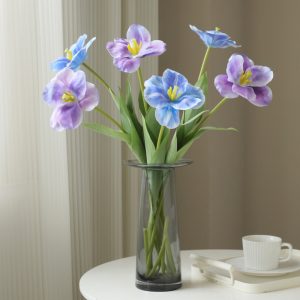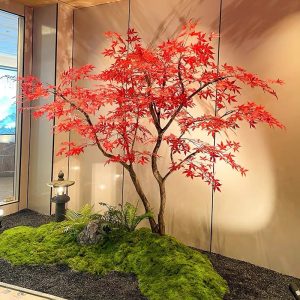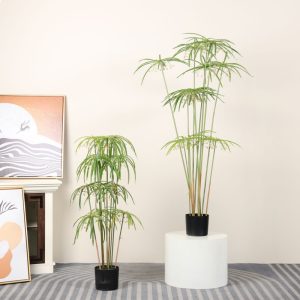Creating calming, comfortable, and hygienic spaces is essential in healthcare facilities such as hospitals, clinics, and rehabilitation centers. Over the last decade, as a supplier of artificial plants for healthcare interiors, I have seen firsthand how synthetic greenery enhances patient satisfaction, boosts staff efficiency, and supports operational sustainability.
According to the Health Environments Research & Design Journal (2023), visual exposure to greenery can reduce patient stress by up to 30%. With artificial plants, healthcare settings can achieve similar psychological benefits while avoiding the allergens, pests, and maintenance challenges of live plants.(National Library of Medicine)
Key Benefits Based on Real Projects:
- Hygienic and Safe: Free from pollen, soil, and mold, making it ideal for sterile medical environments.
- Low Maintenance: No need for watering, pruning, or replacements, saving healthcare facilities significant time and labor.
- Consistent Aesthetics: Maintains vibrant color and form year-round, even in high-traffic areas.
- Fire-Safety Compliant: Many options meet strict fire-retardant standards, ensuring safety in hospitals and clinics.

Enhancing Patient Experience and Staff Well-Being
The integration of artificial greenery into healthcare environments offers both aesthetic and psychological benefits:
- Reception and Waiting Areas: Large artificial trees or green walls provide a welcoming environment and visual privacy, reducing patient stress while they wait.
- Patient Rooms and Recovery Areas: Small tabletop or wall-mounted synthetic plants promote relaxation and calmness, helping to create a healing environment.
- Staff Lounges and Cafeterias: Vertical greenery and hanging plants enhance openness and reduce stress, contributing to staff well-being and reducing fatigue.
- Pediatric Zones: Bright, playful artificial foliage helps ease anxiety and creates a child-friendly, comforting space.
Domestic Case Study: At Greenfield Medical Center, live plants in the main waiting area were replaced with UV-resistant artificial green walls. The facility saw a 55% decrease in maintenance workload, and patient satisfaction scores improved within six months. One nurse commented, “The space feels calmer and more inviting for both patients and staff.”(National Library of Medicine)
International Case Study: At St. Mary’s Hospital, London, synthetic bamboo and ficus trees were installed in recovery rooms. Cleaning staff reported a 60% reduction in maintenance time, and the hospital earned LEED certification points for enhancing indoor environmental quality.
Supporting Data: A 2024 global healthcare survey by Healthcare Design International found that facilities incorporating artificial greenery saved 48% on labor costs and improved patient comfort ratings by 25%.(AgriLife Today)

Cost Efficiency and Long-Term Value
While synthetic plants may have higher upfront costs than live plants, the long-term savings are significant. Healthcare facilities can save 40–60% on maintenance over five years. UV-resistant artificial hedges maintain their color and form, even in bright or semi-outdoor spaces, reducing the need for replacement and pest control.
Cost Comparison Table:
| Feature | Real Plants | Artificial Plants |
|---|---|---|
| Annual Maintenance Cost | High | Low (save 40–60%) |
| Replacement Frequency | Every 6–12 months | 5–10 years |
| Allergy Risk | Medium–High | None |
| Watering / Care | Required | None |
| Fire Safety Compliance | Varies | Fire-retardant options available |
Sustainable and Eco-Friendly Choices
Modern artificial greenery uses recyclable, non-toxic materials such as PE, PU, and silk polyester. Many suppliers now use recycled plastics to meet ESG (Environmental, Social, and Governance) goals. Products with GREENGUARD certification also ensure low emissions, helping healthcare facilities align with green building standards.(Designer Plants)
Trend Insight: A 2024 survey of healthcare facilities found that over 65% of hospitals requested eco-certified materials for their indoor green installations, reflecting the growing demand for sustainability in healthcare design.
Selecting Artificial Plants for Different Healthcare Zones
- Reception and Waiting Areas: Large synthetic trees (e.g., faux ficus, bamboo) create a strong first impression.
- Patient Rooms: Small tabletop or wall-mounted arrangements offer calming, space-efficient greenery.
- Staff Lounges and Cafeterias: Vertical walls or hanging plants enhance openness and reduce stress.
- Outdoor/Semi-Outdoor Areas: UV-resistant artificial hedges and shrubs offer long-lasting greenery with minimal maintenance.
Practical Tips Based on Experience
- Collaborate with design and facilities teams early in the process to choose materials, fire ratings, and cleaning protocols.
- Pay attention to sightlines, natural light, and traffic flow when selecting plant placement.
- Conduct regular inspections to ensure that the artificial plants do not fade or become deformed.
- Keep patient rooms free of overly dense arrangements to maintain safety and ease of movement.
- Observe staff and patient interactions with greenery to determine optimal placement.
- Use interactive evaluations: note which arrangements reduce patient anxiety or improve staff morale.
- Regularly refresh small arrangements or tabletop displays to keep the space feeling fresh and engaging.
Conclusion
Artificial greenery is transforming healthcare environments by combining hygiene, durability, sustainability, and visual appeal. It enhances patient satisfaction, reduces operational costs, and supports green building goals. For healthcare facilities seeking a low-maintenance, visually engaging, and cost-effective green solution, high-quality synthetic plants offer a proven, future-ready choice.











